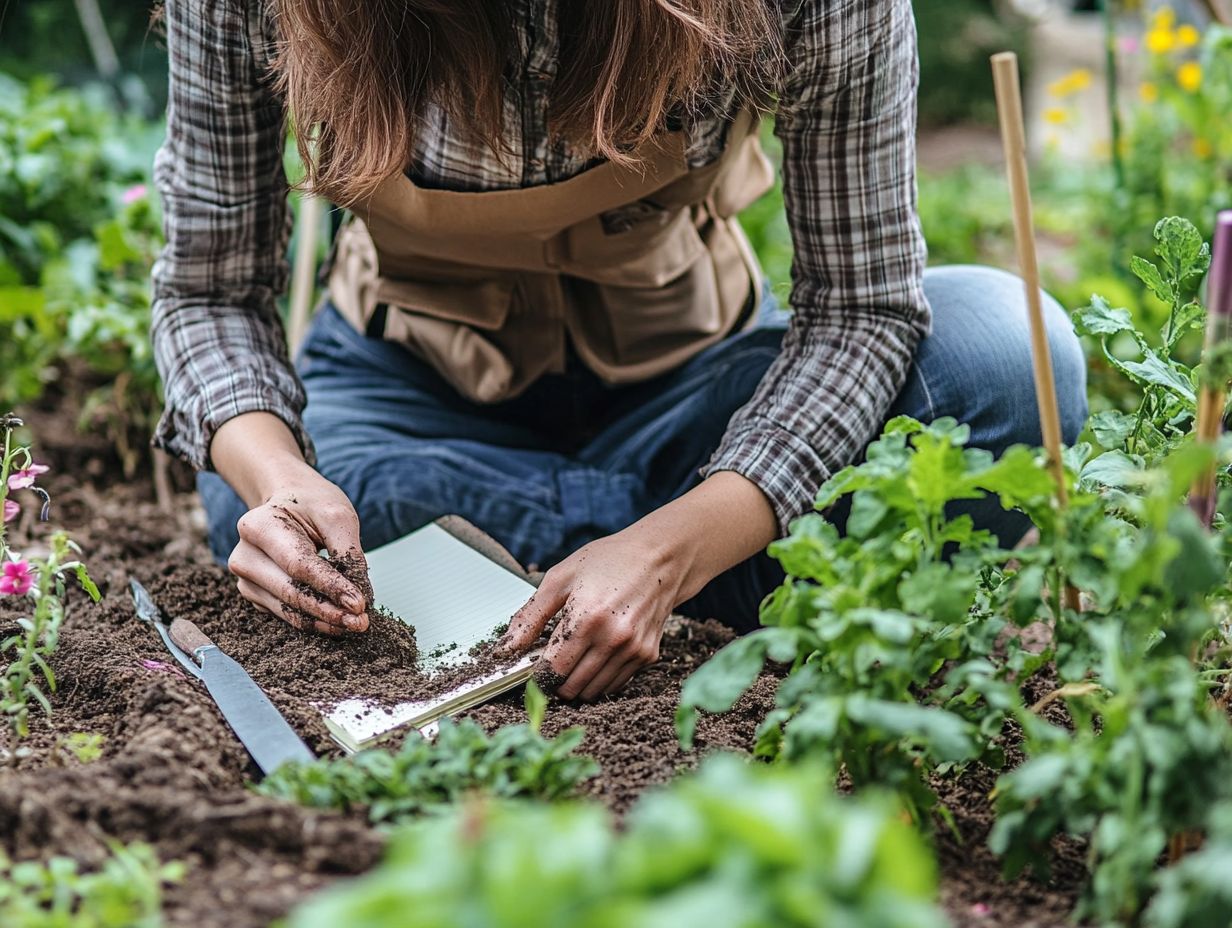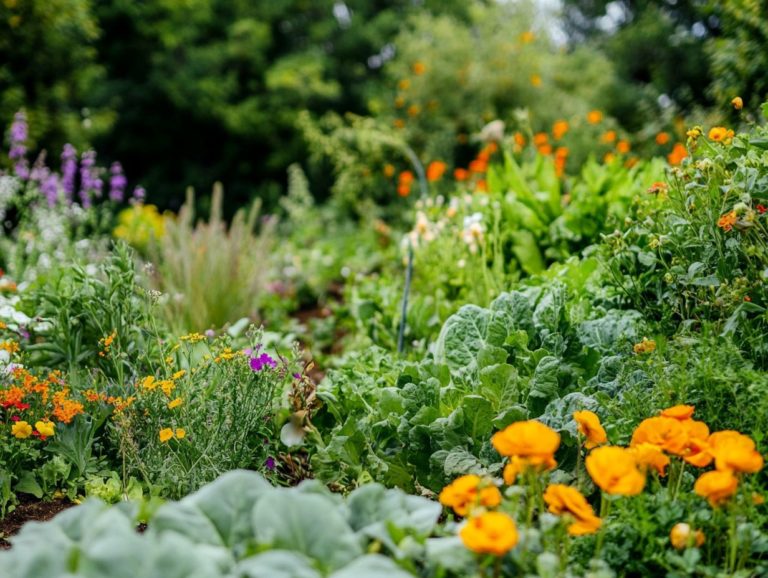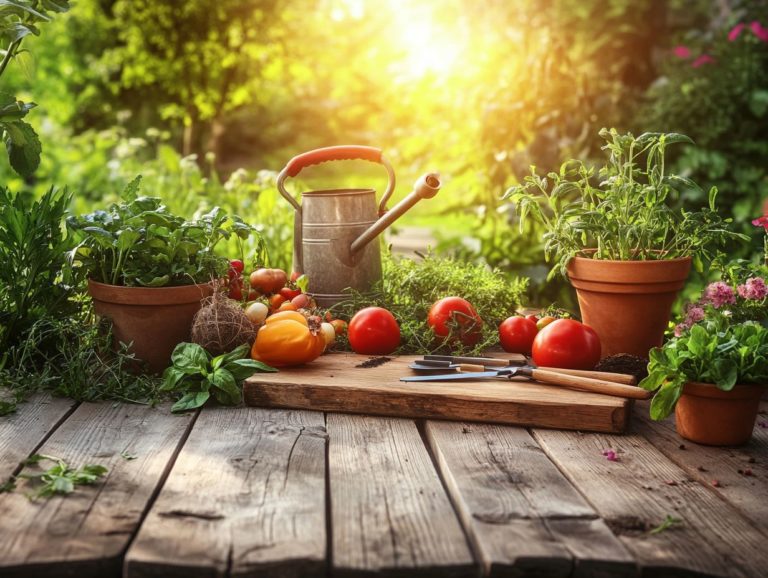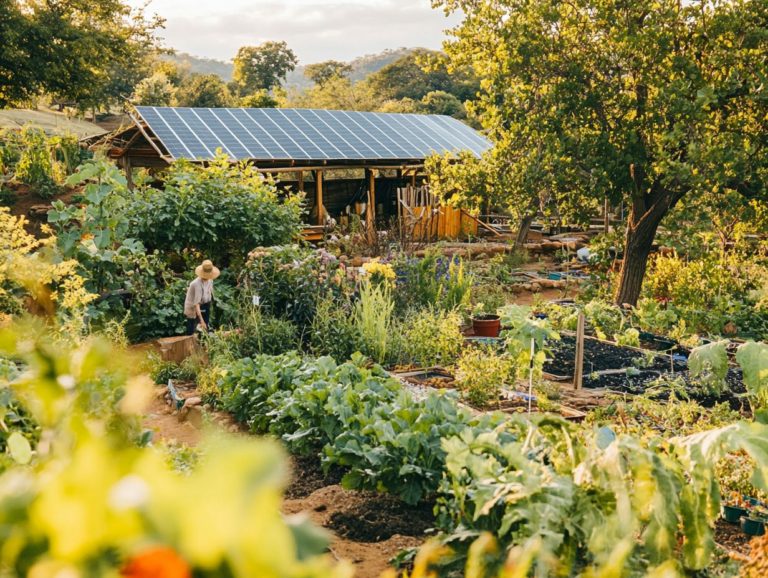How to Analyze Soil Quality for Your Garden?
Healthy soil serves as the cornerstone of your thriving garden. It directly impacts plant growth and overall vitality.
Grasping the nuances of soil quality is essential for you as a gardener. This knowledge is crucial when aiming to cultivate vibrant and productive landscapes.
This article delves into the indicators of poor soil, effective techniques for assessing its quality, and how to decipher soil test results.
Uncover practical strategies to enhance and sustain soil health. These strategies ensure your garden flourishes beautifully for years to come, including tips on soil amendments, which are additives that improve soil quality.
Embark on this journey to learn how to nurture your garden from the ground up. Incorporate gardening techniques that promote healthy soil!
Contents
- Key Takeaways:
- Why Soil Quality Matters for Your Garden
- Signs of Poor Soil Quality
- Methods for Analyzing Soil Quality
- Interpreting Soil Test Results
- Improving Soil Quality
- Maintaining Soil Quality
- Frequently Asked Questions
- What is soil quality and why is it important for my garden?
- How can I analyze soil quality for my garden?
- What is a soil test and how can it help me determine soil quality?
- Can I visually inspect my soil to determine its quality?
- How does plant growth and health indicate soil quality?
- What can I do to improve soil quality for my garden?
Key Takeaways:

- Healthy soil is essential for successful gardening. It directly impacts garden plants and health, contributing significantly to overall soil fertility.
- Common signs of poor soil quality include compacted or dry soil, nutrient deficiencies, and pH levels that are outside the ideal range.
- Methods for analyzing soil quality include soil testing methods through various techniques and tools. These can help identify key issues and guide improvements.
Why Soil Quality Matters for Your Garden
Soil quality is important for gardening success. It affects plant growth, health, and overall productivity.
The composition and condition of your soil dictate its ability to retain moisture and nutrients. This also supports various soil organisms essential for a thriving ecosystem.
Understanding pH levels and soil properties can transform your garden! By prioritizing soil health, you not only boost your garden s growth but also contribute to sustainable practices that benefit the environment.
Impact on Plant Growth and Health
The impact of soil quality on your plants growth and health is profound. Nutrient-rich soil nurtures robust development.
Nutrient deficiencies can lead to stunted growth and poor health in your garden. When you explore the intricate relationship between soil health and plant vitality, it s crucial to recognize how specific nutrients like nitrogen, phosphorus, and potassium play vital roles in shaping growth patterns.
A balanced nutrient level enables your plants to thrive. Conversely, deficiencies, such as a lack of nitrogen that results in yellowing leaves, can hinder their development.
Soil testing is an essential tool for identifying these nutrient imbalances. This allows you to make informed decisions that enhance soil vitality.
By addressing common nutrient deficiencies, you can significantly boost the overall health and resilience of your plants, nurturing lush, vibrant growth.
Signs of Poor Soil Quality
Identifying signs of poor soil quality is crucial for maintaining a flourishing garden. Various indicators can unveil underlying issues that impact soil health and plant vitality.
Pay attention to signs such as inadequate drainage, excessive compaction, or insufficient soil moisture. These can offer valuable insights into your garden’s soil condition.
Fluctuations in soil acidity or alkalinity restrict nutrient availability and hinder plant growth. By recognizing these symptoms early, you can take proactive measures to enhance your soil.
This cultivates a thriving and productive garden environment while effectively managing nutrient levels.
Identifying Common Issues
Identifying common soil quality issues is essential for garden success. Recognizing potential problems allows timely action, possibly with help from a local extension service.
Many gardeners struggle with nutrient deficiencies that hinder plant growth. Soil acidity can disrupt the balance needed for optimal development.
Compaction is another issue that restricts root growth and water drainage, leading to weaker plants. Effective soil testing methods can help diagnose these issues.
By understanding your soil composition, you can make necessary amendments, like adding organic matter and lime, to create a thriving environment for your garden.
Methods for Analyzing Soil Quality

Analyzing soil quality is a key step in ensuring your garden thrives. Various methods to test your soil quality effectively help you assess nutrient levels and overall soil health.
Whether you use a home soil testing kit or send samples to a professional lab, you ll gain valuable insights into pH levels, nutrient content, and moisture retention.
Soil Testing Techniques and Tools
Soil testing techniques range from simple kits to detailed laboratory analyses through local extension services. These tools help you evaluate factors like soil pH and nutrient availability.
Simple kits provide quick insights into soil acidity and nutrient levels at an affordable price. They are perfect for home gardeners or small-scale farmers.
However, while convenient, kits may lack the precision of laboratory tests, which offer comprehensive reports on micronutrients and vital soil elements.
Interpreting Soil Test Results
Interpreting soil test results is crucial for understanding your garden soil’s health. These results reveal the pH levels and nutrient balance necessary for optimal growth.
Focus on key measurements like nitrogen, phosphorus, and potassium levels. These elements directly impact soil fertility and plant performance.
Understanding soil acidity and alkalinity helps you make informed decisions about necessary amendments, enhancing your garden’s health.
Understanding Key Measurements and Indicators
Grasping key measurements from your soil test results is vital for optimizing health. These findings show the balance of essential nutrients like nitrogen, phosphorus, and potassium.
With this information, you can spot nutrient deficiencies and understand how different pH levels affect plant growth. For example, nitrogen supports leafy growth, while phosphorus aids root development and flowering.
Utilizing techniques like crop rotation and cover cropping helps maintain nutrient levels. These methods promote a sustainable garden that stays vibrant and productive.
Improving Soil Quality
Improving soil quality is essential for achieving success in gardening. Adopting effective strategies for soil amendments can result in healthier plants and greater yields.
Techniques such as incorporating compost and organic matter, adjusting soil pH, and boosting the presence of crucial soil organisms like earthworms all play a significant role in enhancing the fertility and structure of your garden soil.
By prioritizing these methods, you can cultivate a nurturing environment that promotes optimal growth. Whether you’re growing vibrant vegetables or delicate flowers, you ll enhance overall soil structure.
Effective Strategies for Enhancing Soil Health

Effective strategies for enhancing soil health are crucial for gardeners. They help maximize the productivity and vitality of plants. Various techniques can be employed to achieve these goals.
One popular approach is crop rotation, where you change the types of crops planted in a specific area each season. This technique helps prevent soil depletion and disrupts cycles of pests and diseases, ultimately leading to stronger, healthier plants.
Cover cropping boosts soil structure and moisture retention while preventing erosion. These temporary plants, sown during the off-seasons, enrich the soil with nutrients when turned back into the ground.
Incorporating compost further enriches your soil with essential organic matter. This boosts the activity of tiny living organisms in the soil and creates a fertile environment that fosters optimal growth.
Maintaining Soil Quality
Maintaining soil quality is essential for sustaining long-term health and ensuring your garden flourishes. By using simple tips, you can significantly enhance soil structure, improve moisture retention, and promote a variety of living things in the soil.
Regularly monitoring soil moisture, practicing crop rotation, and incorporating organic matter are effective strategies for preserving your soil’s vitality. By prioritizing these practices, you ll create a solid foundation for healthy plants, resulting in more productive yields and a thriving gardening ecosystem.
Best Practices for Long-Term Soil Health
Implementing best practices for long-term soil health is essential for you as a gardener dedicated to sustainable and productive gardening. These methods ensure that your soil quality remains optimal over time.
Regular soil testing is a vital step in this journey. It allows you to assess pH levels, nutrient content, and identify any deficiencies that may be lurking beneath the surface.
By incorporating sustainable amendments like compost, organic mulches, and cover crops, you can naturally enrich your soil and enhance its structure.
Maintaining biodiversity among soil organisms will promote a healthier ecosystem, ultimately supporting robust plant growth. These gardening strategies not only lead to improved yields but also build resilience against pests and diseases, making your gardening experience both rewarding and environmentally responsible.
Frequently Asked Questions
Here are some common questions about soil quality.
What is soil quality and why is it important for my garden?
Soil quality refers to the overall health and fertility of the soil. It is important for your garden because it directly affects the growth and productivity of your plants.
How can I analyze soil quality for my garden?

There are several ways to analyze soil quality:
- Conducting a soil test.
- Visually inspecting the soil.
- Observing plant growth and health.
What is a soil test and how can it help me determine soil quality?
A soil test is a process where a sample of soil is analyzed for its nutrient levels, pH balance, and texture. This information can help you determine the overall quality of your soil and what nutrients may be lacking for optimal plant growth.
Can I visually inspect my soil to determine its quality?
Yes, you can visually inspect your soil by looking for certain characteristics such as color, texture, and presence of organic matter. However, a soil test is recommended for a more accurate analysis.
How does plant growth and health indicate soil quality?
Healthy plants thrive in quality soil. If your plants are struggling or show signs of lacking nutrients, poor soil may be the issue.
What can I do to improve soil quality for my garden?
To boost soil quality, try adding organic materials like compost or manure. You can also adjust the soil’s acidity using lime or sulfur.
Regularly rotating your crops helps prevent nutrient depletion. A soil test can offer tailored advice for your specific garden needs.






